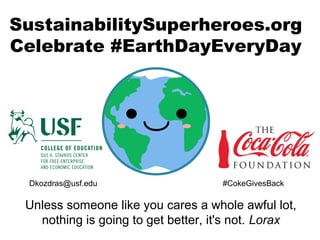Pinellas k sustainability superheroes
- 1. SustainabilitySuperheroes.org Celebrate #EarthDayEveryDay Unless someone like you cares a whole awful lot, nothing is going to get better, it's not. Lorax Dkozdras@usf.edu #CokeGivesBack
- 4. U.N. Definition of Sustainable Development In 1987, the UN Brundtland Commission defined sustainable development as: "meeting the needs of the present without compromising the ability of future generations to meet their own needs." (Report of the World Commission on Environment and Development.)
- 5. Sustainability: Triple Bottom Line
- 6. Solutions for Sustainable Development
- 7. Problems Not Included in Traditional Circular Economy Model: Scarcity and Externalities Kindergarten Econ -Wants and Needs -People work to buy things they want and need
- 9. Physical Science: Recognize that the shape of materials such as paper and clay can be changed by cutting, tearing, crumpling, smashing, or rolling. Properties of matter: Sort objects by observable properties, such as size, shape, color, temperature (hot or cold), weight (heavy or light) and texture. Life Science: Recognize the five senses and related body parts.
- 10. OWL Observe: Owl book Wonder: Questions about protecting the earth Learn: what did you learn? https://www.fs.usda.gov/main/conservationeducation/smokey-woodsy/woodsy- owl/activity-guide
- 11. Historic Primary Sources: Give a Hoot DESCRIPTION Of the many core responsibilities of citizenship, the most basic has been being a Ī░good citizen.Ī▒ The founding generation believed that liberty and freedom could only survive if the Republic and its people were virtuous. For them, and still today, this means respecting the countryĪ»s institutions, fulfilling civic duties, contributing to the community, and generally being a good neighbor, such as advertised in this 1971 public service poster. DATE MADE 1970s PRODUCER Department of Agriculture MEASUREMENTS overall: 18 1/2 in x 13 in; 46.99 cm x 33.02 cm EXHIBITION LOCATION National Museum of American History https://www.youtube.com/watch?v=gZB7gSQRIuM https://americanhistory.si.edu/collections/search/object/nmah_529340
- 12. Woodsy Owl Lend a hand, care for the land
- 13. What happens when we donĪ»t care for the land?
- 14. Engage What do you observe?
- 15. OWL
- 16. What do you observe? What do you wonder?
- 17. OWL
- 18. Engage Experiment ? I wonder what will happen to these items if we bury them? ? Plant the three items ? Predictions in sustainability Superhero notebooks.
- 19. Explore: A Mushy Banana
- 22. OWL
- 23. Explore ? Sid the Science Kid video ? Readworks texts
- 25. Evaluate: How and Why? How did the ______ (not) change? Why did the ______ (not) change?
- 26. Evaluate ? Put the garbage back on the table. ? Did we come up with enough ways to ? What would you do with these different types of garbage.
- 27. OWL
- 28. Extend Peg and Cat Estimate
- 29. Extend from Trash to Treasure
- 30. Extend ? Trash to Treasure
- 31. Text Set Save the Earth . . .
- 33. Make Your Own Tune https://www.flocabulary.com/instrumentals/ Things donĪ»t have to go on this way. We can reduce trash, We can start right away. Take your lunch in a bag, but donĪ»t throw it away. Use the bag or a lunch box again the next day. Use both sides of your paper, and I have no doubt There will be much less paper for you to throw out! Rather than tossing Your old clothes, toys, and shoes, Donate them. TheyĪ»re things Other people can use. Things donĪ»t have to go on this way. We can ____________________ ___________________________ ___________________________ ___________________________ Rather than_________________ ___________________________ ___________________________ ___________________________
- 35. Sustainability Superheroes Adopt- A-Road Problem ?Which road should our class adopt? Alternatives ?What are the different roads? Criteria ?What might impact which road to adopt? Decision ?Which road did your class adopt? How did you make that decision?
- 36. Image Analysis What do I see? What do I think? What do I wonder?
- 37. ? What is litter? ? What problems are caused by litter? ? What choices can you make to help solve the problems caused by litter? Read the informational text.
- 38. Read the text. ? https://www.conserve-energy-future.com/various-littering-facts.php
- 41. Learn about Adopt-A-Road ? https://www.youtube.com/watch?
- 42. Data set What criteria should we consider in choosing which street to adopt?
- 43. Rank the alternatives. Guiding/reflective Questions ?Which road would be the best road to adopt? ?Why do you think that would be the best road? ?What category on the data set is the most important to you? ?Which road would be your next choice? And after that? ?Do you agree with your group's ideas? Why or why not?
- 44. Write back to The Lorax
- 45. Extend the learning. ? Have student groups present their decisions to the class and discuss how they decided which road to adopt. Create a poster that highlights the importance of adopting this particular road. ? Research which roads in the community are a part of the Adopt-A-Highway program. Involve parents to take pictures of these signs to share in class. ? Put it to work! Plan a clean up time for a safe, near-by area that allows students to contribute to the community as responsible citizens. ? Substitute symbols for criteria (e.g. cars instead of traffic lights; trash cans instead of frowny faces)
- 46. The Real Lorax? From Nature.com













































